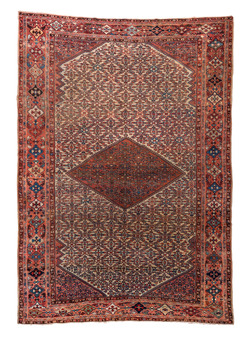Antique handmade oversized carpet No. 64463 Sultanabad, ca. 1910 Iran 432 x 310 cm

Larger images (will open in new window)
Please click on the thumbnails below for a larger view
| main view |
Image 2 |
Image 3 |
Image 4 |
Image 5 |
 |
 |
 |
 |
 |
| Image 6 |
Image 7 |
Image 8 |
Image 9 |
Image 10 |
 |
 |
 |
 |
 |
| Image 11 |
Image 12 |
 |
 |
| Item Number: |
64463 |
| Name: |
Sultanabad, ca. 1910 |
| Country of Origin: |
Iran |
| Size: |
432 x 310 cm |
| Made:
|
ca. 1910 |
| Pile: |
wool |
| Design: |
geometric / medallion |
| Ground Color: |
beige |
| Remarks: |
This is a unique handmade / hand-knotted / traditional oriental carpet
The pile of this carpet is made of wool |
 add to cart
add to cart
More about the provenance Sultanabad, ca. 1910 | Iran
Sultanabad (now Arak), is located in West Persia in the province of Hamadan and has been established 1808. Today Sultanabad has a significant carpet industry. In 1883 a Swiss man called Ziegler founded an import company in Manchester, England and at the same time a rug manufactory in Sultanabad, Iran. In this manufactory they produced rugs of high quality in beautiful tone in tone pastel colors and allover designs inspired by Mahal and Farahan designs which were made mainly for the European taste. The success and the demand were huge and "Ziegler" became an international trademark and a guarantee for beautiful high quality rugs. Rugs of high quality and high durability were made in Sultanabad, as this one is a very nice example of.
This Sultanabad, ca. 1910 has a "Herati" or "Mahi" design (has its origin in Herat, ca. 16th century, short for "Mahi to Hos" meaning "fish in the pond"). A rosette is surrounded by a rhombus which is again surrounded by four bent leaves. The name "Mahi" meaning "fish" was given to this design because the leaves resemble swimming fish.

